That's right the No Headphone Amp!
It's very inexpensive because, well there's no headphone amp and it's very transparent because ... you guessed it, there's no headphone amp!
Looking at Blues' Cool Head 'amp' (The WarpSpeediER) pdf I noticed this:
View attachment WarpspeediER - The Lightning Bug Headphone attenuator.pdf
The output impedance of our Source/DAC will determine how much max current it is capable of delivering. For a given max output voltage (>/= 2 Vrms), the lower the Source/DAC Zout (</= 200 ohms) the more current is available, and is preferred for all phones -from 16 ohms through 600 ohms. A Source or DAC that touts very low Zout (<50 ohms) but smokes its output stage when accidentally shorting the output connectors is not a good design.
He makes a good point that we have all the voltage swing we need and really it's about can the output stage supply the current?
Well, how much power do headphones need?
To rock out on a 32-ohm/98dB/1mW HP we essentially will need lower than 600 ohms for Source Zout. For higher impedance HPs like 300-ohm Sennheisers (102dB/1V = 107dB/1mW!) or 600-ohm BeyerDynamics, higher Source Zouts(>/= 300 ohms) will still generate thunder in our heads. Remember that an 88dB SPL directly into our ears (a mere 0.1mW on 98dB/1mW HPs -that's 1.77mA on a 32-ohm HP or 245mV on 600-ohm HP!) is already very loud, albeit good quality loud through the Warpspeed. I hope not one of us aspires for 100dB SPLs directly into our ear canals –this number is acceptable with loudspeakers in a typical listening room volume with furniture, other sound absorbing materials, and we are 8 feet away. 90dB to 93dB peaks however are plenty loud for headphones.
Hmmmm ... I have some sort of optical volume around here ...
Aha!

http://www.ska-audio.com/diy/optivol.html
SKA's optivol is very basic: 28k in series and then LDR shunt. The output is off the LDR shunt. (so just a single matched pair of LDRs for stereo)
A single log pot drives a current source I think through both LDRs. It was my entry into LDRs for a nice $30!

I hacked it to make the No Headphone Amp: LDR in series then headphone element as shunt (no shunt resistor)! About as simple as you can get: a variable resistor then the headphones!

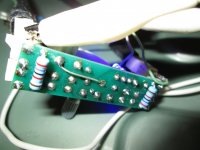

I have Sony MDR-EX71SL IEMs:
Driver Unit : 9mm
Frequency Response : 6Hz - 23,000Hz
Impedance : 16 ohms
Sensitivity (db) : 100dB/mW? (higher!)
Power Handling Capacity : 100mW
and AKG311 'ear buds':
Frequency Response 18Hz - 20.5kHz
Maximum Input Power 15 mW
Input Impedance 32 ohms
Sensitivity: 125 dB SPL
and old over-the-ear AKG K301s:
Sensitivity 94 dB SPL/mW
Frequency range 20 to 25,000 Hz
Rated impedance 120 ohms
THD <1%
Max. input power 200 mW
I measured the impedance with the 3 different headphones hooked up and regular listening was between 700 ohms and 1.5k. 😱
I have the No Headphone Amp hooked up to a USB dac with 2V out and reasonable drive and ... it sounds good! On the AKG K301s (120 ohm) it sounds perfect but with the IEMs and loud volume I think I'm detecting some distortion (700 ohm)
And really, you don't have to use an LDR. You could use a pot, attenuator or even a few resistors (next test!)
No Headphone Amp really is best! 😀
Cheers,
Jeff
It's very inexpensive because, well there's no headphone amp and it's very transparent because ... you guessed it, there's no headphone amp!

Looking at Blues' Cool Head 'amp' (The WarpSpeediER) pdf I noticed this:
View attachment WarpspeediER - The Lightning Bug Headphone attenuator.pdf
The output impedance of our Source/DAC will determine how much max current it is capable of delivering. For a given max output voltage (>/= 2 Vrms), the lower the Source/DAC Zout (</= 200 ohms) the more current is available, and is preferred for all phones -from 16 ohms through 600 ohms. A Source or DAC that touts very low Zout (<50 ohms) but smokes its output stage when accidentally shorting the output connectors is not a good design.
He makes a good point that we have all the voltage swing we need and really it's about can the output stage supply the current?
Well, how much power do headphones need?
To rock out on a 32-ohm/98dB/1mW HP we essentially will need lower than 600 ohms for Source Zout. For higher impedance HPs like 300-ohm Sennheisers (102dB/1V = 107dB/1mW!) or 600-ohm BeyerDynamics, higher Source Zouts(>/= 300 ohms) will still generate thunder in our heads. Remember that an 88dB SPL directly into our ears (a mere 0.1mW on 98dB/1mW HPs -that's 1.77mA on a 32-ohm HP or 245mV on 600-ohm HP!) is already very loud, albeit good quality loud through the Warpspeed. I hope not one of us aspires for 100dB SPLs directly into our ear canals –this number is acceptable with loudspeakers in a typical listening room volume with furniture, other sound absorbing materials, and we are 8 feet away. 90dB to 93dB peaks however are plenty loud for headphones.
Hmmmm ... I have some sort of optical volume around here ...
Aha!

http://www.ska-audio.com/diy/optivol.html
SKA's optivol is very basic: 28k in series and then LDR shunt. The output is off the LDR shunt. (so just a single matched pair of LDRs for stereo)
A single log pot drives a current source I think through both LDRs. It was my entry into LDRs for a nice $30!

I hacked it to make the No Headphone Amp: LDR in series then headphone element as shunt (no shunt resistor)! About as simple as you can get: a variable resistor then the headphones!



I have Sony MDR-EX71SL IEMs:
Driver Unit : 9mm
Frequency Response : 6Hz - 23,000Hz
Impedance : 16 ohms
Sensitivity (db) : 100dB/mW? (higher!)
Power Handling Capacity : 100mW
and AKG311 'ear buds':
Frequency Response 18Hz - 20.5kHz
Maximum Input Power 15 mW
Input Impedance 32 ohms
Sensitivity: 125 dB SPL
and old over-the-ear AKG K301s:
Sensitivity 94 dB SPL/mW
Frequency range 20 to 25,000 Hz
Rated impedance 120 ohms
THD <1%
Max. input power 200 mW
I measured the impedance with the 3 different headphones hooked up and regular listening was between 700 ohms and 1.5k. 😱
I have the No Headphone Amp hooked up to a USB dac with 2V out and reasonable drive and ... it sounds good! On the AKG K301s (120 ohm) it sounds perfect but with the IEMs and loud volume I think I'm detecting some distortion (700 ohm)
And really, you don't have to use an LDR. You could use a pot, attenuator or even a few resistors (next test!)
No Headphone Amp really is best! 😀
Cheers,
Jeff
Last edited:
Thanks for referencing my work, Jeff...very much appreciated. Welcome to direct-drive headphones listening, it's quite an ear-opening experience.


Ok, now I've gone oooooooooooooollllld school! 😎
No Headphone Amp with a single resistor!
1 resistor!
USB Dac --> 909 ohm resistor --> headphones
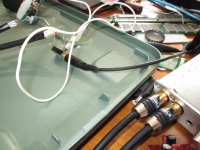
1 resistor! (and spaghetti connectorization)

Ya, alligator clip old school: Samuel L. Jackson: "Oh, now we gonna alligata' yo ***!"

I'm using the big AKG K301s (120 ohm) so my DAC is driving 909 + ~120 = 1029
So about 1k ... so far so good!
Later I'll try the 32 and ... 16 ohm earbuds and IEMs = 925 ohm 😱
The question is ... can your output stage drive your headphones like this? Other headphones might be more efficient or higher res (600 ohm) and your DAC / phono pre would only have to drive 2 or 3k!
Blues puts-it-in-a-nutshell at the end of the doc:
In summary, with the correct components combination of 2Vrms Sources having 200-ohm Zout or less; 16 thru 600-ohm headphones with 93dB/1mW or more are all we need to complement the WarpspeediER –which about covers most dynamic HPs, IEMs, and even some planar mags. Again high voltage electrostatics and low sensitivity planars are not recommended.
No Headphone Amp with a single resistor!
1 resistor!
USB Dac --> 909 ohm resistor --> headphones

1 resistor! (and spaghetti connectorization)

Ya, alligator clip old school: Samuel L. Jackson: "Oh, now we gonna alligata' yo ***!"

I'm using the big AKG K301s (120 ohm) so my DAC is driving 909 + ~120 = 1029
So about 1k ... so far so good!
Later I'll try the 32 and ... 16 ohm earbuds and IEMs = 925 ohm 😱
The question is ... can your output stage drive your headphones like this? Other headphones might be more efficient or higher res (600 ohm) and your DAC / phono pre would only have to drive 2 or 3k!
Blues puts-it-in-a-nutshell at the end of the doc:
In summary, with the correct components combination of 2Vrms Sources having 200-ohm Zout or less; 16 thru 600-ohm headphones with 93dB/1mW or more are all we need to complement the WarpspeediER –which about covers most dynamic HPs, IEMs, and even some planar mags. Again high voltage electrostatics and low sensitivity planars are not recommended.
Last edited:
Interesting. The .pdf author credits nwavguy but ignores his recommendations.
NwAvGuy: Headphone & Amp Impedance
NwAvGuy: Headphone & Amp Impedance
I agree, if you want proper damping you should use a <4 ohm resistor (for 32 ohm headphones) in parallel with the load. Most sources won't like such a load..
Now my setup is a little different than the WarpSpeedIER because it has a shunt resistor in parallel with the phones.
But lets look at my case, you have a pretty pure 909 ohm resistance into something like:
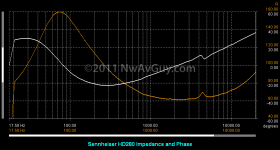
(from NwAvGuy, I'll reference later)
This is the HD280 but its typical of a 120 ohm phone: resonance around 100Hz, dip to 60 ohm and slight rise back towards 100 ohm.
I should be hearing a big peak at 80 Hz but I don't ... Hmmm....
But lets look at my case, you have a pretty pure 909 ohm resistance into something like:

(from NwAvGuy, I'll reference later)
This is the HD280 but its typical of a 120 ohm phone: resonance around 100Hz, dip to 60 ohm and slight rise back towards 100 ohm.
I should be hearing a big peak at 80 Hz but I don't ... Hmmm....
Should be almost +8 dB at the resonant frequency. Less control over the driver also increases distortion.
Btw, the HD280 is a 64 ohm (nominal) headphone.
Btw, the HD280 is a 64 ohm (nominal) headphone.
Excellent! Exactly the sort of things running through my head!

This will provide concrete anchors:
WHY DOES OUTPUT IMPEDANCE MATTER? It matters for at least three reasons:
1) The greater the output impedance the greater the voltage drop with lower impedance loads. This drop can be large to enough to prevent driving low impedance headphones to sufficiently loud levels. A real world example is the Behringer UCA202 with a 50 ohm output impedance. It struggles with some 16 - 32 ohm headphones.
2) Headphone impedance changes with frequency. If the output impedance is much above zero this means the voltage delivered to the headphones will also change with frequency. The greater the output impedance, the greater the frequency response deviations. Different headphones will interact in different, and typically unpredictable, ways with the source. Sometimes these variations can be large and plainly audible.
3) As output impedance increases electrical damping is reduced. The bass performance of the headphones, as designed by the manufacture, may be audibly compromised if there’s insufficient damping. The bass might become more “boomy” and less controlled. The transient response becomes worse and the deep bass performance is compromised (the headphones will roll off sooner at low frequencies). A few, such as those who like a very warm “tube like” sound, might enjoy this sort of under damped bass. But it’s almost always less accurate compared to using a low impedance source.
From a great article:
NwAvGuy: Headphone & Amp Impedance
And related:
NwAvGuy: Headphone Impedance Explained
(thanks xnor, the K301 is ooooold ... for now I'll just double everything to explore the concept: peak 300 ohm drop to 120 ohm and rise to 200 ohm)
Just quick because I have to go play in the snow with my son,
1) Not a problem as stated because what I'm driving is:
909 + lowest dip (120 ohm) = ~1k
And the volume is fine--this is an 'attenuator'!
2) 120/1k = 12%, 300/1k = 30% a diff of 18% ... not too big and I don't think I'm hearing the resonance or the high freq lift
3) Damping ... hmmm this I'm not sure about and would love to hear some thoughts. My first one is that this sort of thing may matter more for loudspeaker divers than headphones. Whatever it is, it can't be too bad because I just don't have a 100 ohm output impedance but almost 1000 ohm! 😱
I'd like to explore this apparently non-ideal setup and it's real effects and then move on to what happens when adding a lower value shunt resistor across the headphones.
Cheers,
Jeff
PS Counter Culture, I was getting to that ... and I thought the light tone of the thread was apparent?

This will provide concrete anchors:
WHY DOES OUTPUT IMPEDANCE MATTER? It matters for at least three reasons:
1) The greater the output impedance the greater the voltage drop with lower impedance loads. This drop can be large to enough to prevent driving low impedance headphones to sufficiently loud levels. A real world example is the Behringer UCA202 with a 50 ohm output impedance. It struggles with some 16 - 32 ohm headphones.
2) Headphone impedance changes with frequency. If the output impedance is much above zero this means the voltage delivered to the headphones will also change with frequency. The greater the output impedance, the greater the frequency response deviations. Different headphones will interact in different, and typically unpredictable, ways with the source. Sometimes these variations can be large and plainly audible.
3) As output impedance increases electrical damping is reduced. The bass performance of the headphones, as designed by the manufacture, may be audibly compromised if there’s insufficient damping. The bass might become more “boomy” and less controlled. The transient response becomes worse and the deep bass performance is compromised (the headphones will roll off sooner at low frequencies). A few, such as those who like a very warm “tube like” sound, might enjoy this sort of under damped bass. But it’s almost always less accurate compared to using a low impedance source.
From a great article:
NwAvGuy: Headphone & Amp Impedance
And related:
NwAvGuy: Headphone Impedance Explained
(thanks xnor, the K301 is ooooold ... for now I'll just double everything to explore the concept: peak 300 ohm drop to 120 ohm and rise to 200 ohm)
Just quick because I have to go play in the snow with my son,
1) Not a problem as stated because what I'm driving is:
909 + lowest dip (120 ohm) = ~1k
And the volume is fine--this is an 'attenuator'!
2) 120/1k = 12%, 300/1k = 30% a diff of 18% ... not too big and I don't think I'm hearing the resonance or the high freq lift
3) Damping ... hmmm this I'm not sure about and would love to hear some thoughts. My first one is that this sort of thing may matter more for loudspeaker divers than headphones. Whatever it is, it can't be too bad because I just don't have a 100 ohm output impedance but almost 1000 ohm! 😱
I'd like to explore this apparently non-ideal setup and it's real effects and then move on to what happens when adding a lower value shunt resistor across the headphones.
Cheers,
Jeff
PS Counter Culture, I was getting to that ... and I thought the light tone of the thread was apparent?
Last edited:
I thought the light tone of the thread was apparent?
We are inundated with technically inaccurate assertions here all day, every day, having them presented in a lighthearted manner doesn't make them any more palatable.
So let's look at this...
1) Not a problem as stated because what I'm driving is:
909 + lowest dip (120 ohm) = ~1k
And the volume is fine--this is an 'attenuator'!
You're not driving 909 + 120 ohms.
You're still driving 120 ohms, you've just increased the driving (source) impedance by 909 ohms.
Lighthearted huh? LMFAO.
...
You're not driving 909 + 120 ohms.
You're still driving 120 ohms, you've just increased the driving (source) impedance by 909 ohms ...
I know that and my idea wasn't phrased right. The point I was trying to make is that I'm not in danger of my source resistance eating up all my voltage swing and not getting enough volume. This was the reasoning behind point 1. In my case I'm trying to do that--it's an attenuator.
...
We are inundated with technically inaccurate assertions here all day, every day, having them presented in a lighthearted manner doesn't make them any more palatable ...
I didn't realize I was coming across that way.
?...
LMFAO ...
Last edited:
Sure it's attenuating, but ideally the output impedance is close to zero regardless of volume control position.
Interesting. The .pdf author credits nwavguy but ignores his recommendations...
Like I mentioned... "...their website and blogs that helped me have a better perspective of what I was trying to accomplish." It does not necessarily mean I agree to all their findings.
The solution is kinda counter-culture, isn't it? Established culture being to add another gain stage, with an input stage that cannot take the full source output voltage, adding a pot to attenuate the input signal so as to not clip the output, an output stage that might not have enough juice to supply a low Z load, cure all that ails it with feedback, and so on...
It's easy enough to give Jeff's suggestions here a try which I encourage all to diy and find out.
Like Jeff said, we have enough output voltage from modern sources we can even afford to lose some by attenuation...
I want to stress that the WarpSpeedIER is different in that it has a low value shunt resistance across the headphones which ... changes things. I would like to save that for later or maybe even a different thread.
And yes Blues, the cheesy pictures of the bad hack job circuit were
intended to get people to try ... it can't be worse than mine! 😛
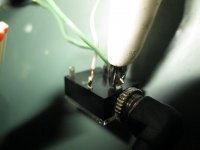
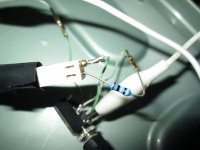
See!
Surely you have some old, cut-up RCAs around somewhere and surely you have a 1/8" or 1/4" jack around and surely some 1k resistors and surely some way to crimp/clip/twist/ ... solder even! them together and ... stop calling me Shirley. Hmmm, that joke works better when spoken ... 😉
Try it and see how it sounds! Maybe we could get some real measurements posted ...
We have enough voltage swing with the standard 2Vrms and ... well possibly enough current to drive ~1k ... depends on the particular output stage. I want to focus on points 2 (freq resp) and 3 (lack of damping, distortion).
Anyway to continue with this technically incorrect circuit ...
I just plugged my IERs in! These are one of the inexpensive ones Linkwitz looked at: Sony MDR-EX71SL
Brutal 16 ohms (like a mini speaker?!?) and 100dB/mW 😱
So that's DAC output impedance (~100 ohm), 909 ohm and the nominal 16 ohm IER. My DAC's seeing 925 ohm and so far ... sounds ok?!?
... sounds ok?!? 
With IERs the case is different, here's an impedance chart of the Sony MDR-EX51:
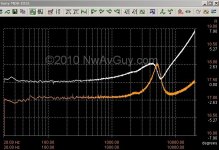
NwAvGuy: Headphone Impedance Explained
The graph is a bit deceptive, note the scale! As NwAvGuy points out:
WHAT ABOUT TYPICAL EARBUDS? The vast majority of reasonably priced dynamic (not balanced armature) earbuds headphones have a 16 or 32 ohm nominal impedance that might vary by just 1 or 2 ohms. Here's the popular Sony MDR-EX51 which is mostly 17 ohms and rises to 18 ohms at its 5 khz resonance:
So here point 2 falls away because I don't have a wildly swinging impedance to screw up the freq resp.
In fact many headphones don't: you can check at
Learning Center - Build a Headphone Graph | HeadRoom Audio
Here's a bunch
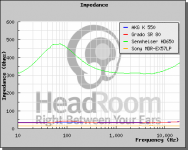
So with my smooth, 16 ohm impedance IERs plugged in, that leaves NwAvGuy's point 3)
As output impedance increases electrical damping is reduced. The bass performance of the headphones, as designed by the manufacture, may be audibly compromised if there’s insufficient damping. The bass might become more “boomy” and less controlled. The transient response becomes worse and the deep bass performance is compromised (the headphones will roll off sooner at low frequencies). A few, such as those who like a very warm “tube like” sound, might enjoy this sort of under damped bass. But it’s almost always less accurate compared to using a low impedance source.
Reduction of electrical damping leading to:
A) bass "boomy", less controlled
B) worse transient response
c) higher LF rolloff
Two things come to mind:
I need to understand the properties of the headphone element--Qm, Qe and Qt
How pronounced will A, B, and C be under actual conditions?
What do you guys think?
Cheers,
Jeff
And yes Blues, the cheesy pictures of the bad hack job circuit were
intended to get people to try ... it can't be worse than mine! 😛


See!

Surely you have some old, cut-up RCAs around somewhere and surely you have a 1/8" or 1/4" jack around and surely some 1k resistors and surely some way to crimp/clip/twist/ ... solder even! them together and ... stop calling me Shirley. Hmmm, that joke works better when spoken ... 😉
Try it and see how it sounds! Maybe we could get some real measurements posted ...
We have enough voltage swing with the standard 2Vrms and ... well possibly enough current to drive ~1k ... depends on the particular output stage. I want to focus on points 2 (freq resp) and 3 (lack of damping, distortion).
Anyway to continue with this technically incorrect circuit ...
I just plugged my IERs in! These are one of the inexpensive ones Linkwitz looked at: Sony MDR-EX71SL
Brutal 16 ohms (like a mini speaker?!?) and 100dB/mW 😱
So that's DAC output impedance (~100 ohm), 909 ohm and the nominal 16 ohm IER. My DAC's seeing 925 ohm and so far
 ... sounds ok?!?
... sounds ok?!? 
With IERs the case is different, here's an impedance chart of the Sony MDR-EX51:

NwAvGuy: Headphone Impedance Explained
The graph is a bit deceptive, note the scale! As NwAvGuy points out:
WHAT ABOUT TYPICAL EARBUDS? The vast majority of reasonably priced dynamic (not balanced armature) earbuds headphones have a 16 or 32 ohm nominal impedance that might vary by just 1 or 2 ohms. Here's the popular Sony MDR-EX51 which is mostly 17 ohms and rises to 18 ohms at its 5 khz resonance:
So here point 2 falls away because I don't have a wildly swinging impedance to screw up the freq resp.
In fact many headphones don't: you can check at
Learning Center - Build a Headphone Graph | HeadRoom Audio
Here's a bunch

So with my smooth, 16 ohm impedance IERs plugged in, that leaves NwAvGuy's point 3)
As output impedance increases electrical damping is reduced. The bass performance of the headphones, as designed by the manufacture, may be audibly compromised if there’s insufficient damping. The bass might become more “boomy” and less controlled. The transient response becomes worse and the deep bass performance is compromised (the headphones will roll off sooner at low frequencies). A few, such as those who like a very warm “tube like” sound, might enjoy this sort of under damped bass. But it’s almost always less accurate compared to using a low impedance source.
Reduction of electrical damping leading to:
A) bass "boomy", less controlled
B) worse transient response
c) higher LF rolloff
Two things come to mind:
I need to understand the properties of the headphone element--Qm, Qe and Qt
How pronounced will A, B, and C be under actual conditions?
What do you guys think?
Cheers,
Jeff
Last edited:
No Headphone Amp really is best! 😀
No, it's not. You can run some phones in the manner you describe, but in many instances the results will be less than optimum. A lot less than optimum in some instances. You have chosen to highlight a case where the disadvantages are minimized, but this is far from typical.
So here point 2 falls away because I don't have a wildly swinging impedance to screw up the freq resp.
No, YOU don't.
In fact many headphones don't.
But many do. Which is the whole point.
How pronounced will A, B, and C be under actual conditions?
Pronounced enough to be worthy of note, otherwise he wouldn't have bothered mentioning them.
So why don't you tell people, 'You can run your headphones straight off a DAC, but the results may not be good.' - which is the simple truth, which you seem determined to avoid acknowledging, presumably because it would show up this thread for the nonsense it is.
It's not good advice for most people, particularly people with limited technical knowledge. Which is what makes it reprehensible for you to continue to promote it as unequivocally beneficial when you have been explicitly advised that there are circumstances in which, for sound technical reasons, the results may not be good.
Dear people, you can run your headphones straight off a DAC, but the results may not be good.
This thread is an attempt to explore why my headphones don't sound as bad as I thought they should when hooked up in this wrong manner.
I'm trying to walk through slowly and address specific points in my particular situation. I'm purposely trying to keep things simple so people with less technical knowledge can see where and why this circuit does and doesn't work in my case.
***Please don't generalize any of my very specific, unmeasured and hastily drawn conclusions to your own headphones or output stages***
There are circumstances in which, for sound technical reasons, the results may not be good.
Perhaps if we technically analyze, listen to, measure and generally explore these circumstances we can make the results less not be good.
If you want you could build this simple Do It Yourself circuit and see ... or hear! Ha! ... what these frequency response variations, undamping, and distortions sound like. You could use this hands-on knowledge to evaluate future projects!
With really bad puns like:
No Headphone Amp really is best! 🙂
That don't even make grammatical sense and leave themselves open to wide interpretation and circuits held together with clips and crimps and no measurements this thread may end up being nonsense ! Heck maybe it already is!
But maybe I can learn something. So, any thoughts about impedance, damping and the mechanical and electrical Qs of headphone drivers? In particular, smoother impedance IEMs and more peaky 120 ohm over-the-ear headphones.
Cheers,
Jeff
This thread is an attempt to explore why my headphones don't sound as bad as I thought they should when hooked up in this wrong manner.
I'm trying to walk through slowly and address specific points in my particular situation. I'm purposely trying to keep things simple so people with less technical knowledge can see where and why this circuit does and doesn't work in my case.
***Please don't generalize any of my very specific, unmeasured and hastily drawn conclusions to your own headphones or output stages***
There are circumstances in which, for sound technical reasons, the results may not be good.
Perhaps if we technically analyze, listen to, measure and generally explore these circumstances we can make the results less not be good.
If you want you could build this simple Do It Yourself circuit and see ... or hear! Ha! ... what these frequency response variations, undamping, and distortions sound like. You could use this hands-on knowledge to evaluate future projects!
With really bad puns like:
No Headphone Amp really is best! 🙂
That don't even make grammatical sense and leave themselves open to wide interpretation and circuits held together with clips and crimps and no measurements this thread may end up being nonsense ! Heck maybe it already is!
But maybe I can learn something. So, any thoughts about impedance, damping and the mechanical and electrical Qs of headphone drivers? In particular, smoother impedance IEMs and more peaky 120 ohm over-the-ear headphones.
Cheers,
Jeff
Last edited:
There's two issues here that tend to get confused, on purpose I believe by some headphone makers, and by Wikipedia.
One is the source impedance expected by the headphones, the other is the load impedance expected by the source.
If headphones with significant variation in impedance with frequency are driven with a source impedance other than what the headphones were tested with, then the frequency response will change with respect to the published data. Some Sennheisers' bass can be emphasised, for example, with a low-impedance source. AKGs, OTOH, appear almost exactly as a pure resistance, so don't care much. The relationship between frequency response and fidelity is a tricky issue for headphones, and I feel the best policy would be to use whatever source impedance the manufacturer used for testing during design.
If the source sees a load much lower than it was designed for, it's output may be distorted...sometimes very badly. Opamps are often not capable of driving headphones directly for example. I guess the "standard" 120 ohm series resistor originated partly for this reason, and partly for safety.
One is the source impedance expected by the headphones, the other is the load impedance expected by the source.
If headphones with significant variation in impedance with frequency are driven with a source impedance other than what the headphones were tested with, then the frequency response will change with respect to the published data. Some Sennheisers' bass can be emphasised, for example, with a low-impedance source. AKGs, OTOH, appear almost exactly as a pure resistance, so don't care much. The relationship between frequency response and fidelity is a tricky issue for headphones, and I feel the best policy would be to use whatever source impedance the manufacturer used for testing during design.
If the source sees a load much lower than it was designed for, it's output may be distorted...sometimes very badly. Opamps are often not capable of driving headphones directly for example. I guess the "standard" 120 ohm series resistor originated partly for this reason, and partly for safety.
.. The relationship between frequency response and fidelity is a tricky issue for headphones, and I feel the best policy would be to use whatever source impedance the manufacturer used for testing during design...
Do you know where to get such info?
Are there any general principles to follow for phones that don't have testing data like old: Sony MDR-EX71SL IEM, AKG311 'ear buds' or really old over-the-ear AKG K301s?
Thanks,
Jeff
Last edited:
- Status
- Not open for further replies.
- Home
- Amplifiers
- Headphone Systems
- The No Headphone Amp!